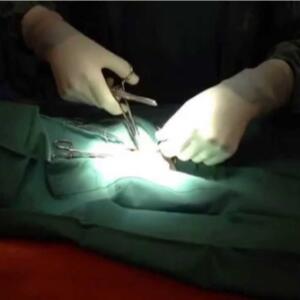For the past 18 years we have promoted early age desexing (EAD), as a practice that safely simplifies the desexing process for new puppy families because it is completed before the puppy comes home. The surgery also has the added benefit of protecting our developing breed – the Australian Labradoodle. Vets and animal welfare groups have for many years promoted EAD as safe from 6 weeks of age but trends are shifting and this year we have found a more consistent push back from vets who are now preferring to defer desexing until puppies are older. Clients too are enquiring more frequently about the option to delay surgery. The good news is we now have a process that safely manages the interests of all parties offering you and your puppy greater choice.
Definitions
We use the term desexing to describe the surgical sterilisation of puppies, usually by castration (removal of the testes) in the male also termed “neutering” or by ovario-hysterectomy (removal of the ovary and uterus) in the female, also termed “spay / spey”. While there are other surgical techniques and procedures that result in surgical sterilisation of dogs, the ones we discuss here are the most common.
How did we get here?
Our processes to date have been to use experienced surgeons who perform surgery quickly (efficiently) through a small incision which enables speedy healing. We use paediatric anaesthetic protocols and specialised equipment suited to paediatric patients. By the time puppies return home and have had a nap and a snack, they are back to rumbling with their litter-mates as if nothing has happened. Their post-op recovery is amazing and long-term health outcomes have been excellent.

Each year, we review our stance on EAD and we have remained abreast of emerging science by sourcing training and advice from respected reproductive veterinary specialists in Australia and New Zealand. A noted shift this year has led us to engage a team able to broaden options for our puppies and their prospective families.
What is ‘SpaySecure’?

In the past few years we have sent a couple of pups home on delayed desexing contracts, usually where it has been medically indicated. This requires additional follow up by me to ensure the surgery is completed and that the family manages the added aspects of sexual maturation of the puppy. It’s not complicated but it does take time. SpaySecure is a third party that manages all aspects of the breeder-client contract regarding delayed spay or neutering for your pet. They also act as a resource for our puppy families and are available to guide you through the process. Check the SpaySecure website to learn more.
As a breeder I will always be on hand to answer your queries but it’s a relief to be able to hand off the contractual aspects of delayed desexing to a specialist team as their expertise allows me to get on with the important aspects of our fantastic puppy rearing program – puppy care, socialisation and training.
How does the science relating to early age desexing apply to the Australian Labradoodle?
There are no studies that look specifically at our breed but the Australian Labradoodle breeders around the world have been desexing puppies before going home at 8 weeks of age, for 20+ years. Across the canine species, the scientific literature presents a range of perspectives regarding the optimal timing of desexing as well as the impact of timing on health outcomes over a dog’s lifetime. There is variation between breeds and size of dog so a broad bush approach is not practical when deciding what is best for you and your puppy.
The majority of Australian Labradoodles fall into the category of being small to medium in size. For this grouping, there is a strong argument to leave the decision as to timing of desexing to the client (puppy parent) where the following considerations are weighed up for each animal:
- behaviour
- sexual development
- surgery – anaesthesia, difficulty, duration, risk and recovery plus cost
- health and disease outcomes across the lifetime (some are more prevalent, others less prevalent with surgery and its timing).
What are your options when buying an Amalie Labradoodle?
As most of our pups fit the category of small to medium, the space where science advocates ‘choice’ as to appropriate timing of desexing surgery, puppies may either be desexed by us prior to coming home or we will engage SpaySecure to support you if you choose to have your pup desexed at a later date. The delayed desexing is conducted by the vet of your choice, at your expense.
One of the many benefits of joining our waiting list early on is that we can have plenty of time to have the requisite conversations and you are able to consult with your vet and then make an un-rushed, informed decision.

What are the basic pros and cons of EAD vs delayed desexing in the Labradoodle?
Risks and benefits are explored in the papers below from the perspective of the animal, society, the owner and health care professional.
To give you a window into Amalie’s early-age desexing experience of over 1000 puppies at around 7 weeks of age between 2008-2023, we have found that in skilled hands and with paediatric protocols and equipment, the surgery is simple and puppies recover rapidly. At Amalie Labradoodles we health test all our breeding stock and exclude animals from our program that do not meet our health testing standards. We believe this goes a long way to minimising joint disease in our program despite the fact that we have routinely undertaken EAD. Our reported incident of joint disease is exceptionally low (cumulatively 2.7 per 1000), with no hip dysplasia. We encourage all our families to continue to feed a premium diet and ensure age-appropriate, physical and social activities in life to support optimum health. We acknowledge that these elements alone do not address all issues raised in the EAD debate, but they will have a positive impact.
With the emergence of new science and that fact that one size does not fit all, discussion of the pros and cons of EAD specific to you and your preferred puppy, is best had with your health professional. You could expect your vet to consider your preferences for size (estimated adult weight) and sex of the puppy in that chat, plus your individual circumstances.
How do you make the decision about when your pet puppy should be desexed?
- Ask a professional – please either chat to your vet or if science is your thing, dive into relevant peer reviewed articles – we have included some references below.
- Consider your own personal circumstances and the puppy you are wanting to adopt especially with regard to sex and size (expected adult weight). To help your gauge size, our
- minis are around 8-10kg
- small mediums are 9-11.5kg
- mediums are 12-17kg
- standards are 18-25+kg
- Consider the length of delay you would plan for if you were to delay desexing and assess if there is a health advantage to your puppy that outweighs any inconvenience of that delay with regard to sexual maturity (such as a heat season in the female) and behaviours in the sexually maturing teenage male ….. or how you might manage these.
- Have a conversation with Tracey – there will be times when we set the desexing date and other times when we will be guided by you.
We are happy to provide guidance but as your vet will be the health professional that you will work with throughout your puppy’s lifetime, their view is important to you and your new puppy. If you are looking to a small or medium sized puppy, you may find the information in this article by Hart et al of particular use to discuss with your vet.
What ever you decide, as an ethical breeder, we can to support your choice.
References:
An Ancient Practice but a New Paradigm: Personal Choice for the Age to Spay or Neuter a Dog
L. Hart and B. Hart
This a relatively easy read presents a good summary of points for consideration when deciding what is the right time for your pup to be desexed.
Front Vet Sci . 2021 Mar 19:8:603257. doi: 10.3389/fvets.2021.603257. eCollection 2021.
https://www.frontiersin.org/articles/10.3389/fvets.2021.603257/full
Assisting decision-making on age of neutering for 35 breeds of dog: associated joint disorders, cancers and urinary incontinence.
Hart BL, Hart LA, Thigpen AP, Willits NH.
I need to consider this paper further – looking at the data for the 3 parent breeds of the labradoodle (Lab, Poodle and Cocker Spaniel) only the first has sizeable numbers included in the analysis of health outcomes.
Front Vet Sci. 2020 Vol 7:388. 10.3389
https://www.frontiersin.org/articles/10.3389/fvets.2020.00388/full
Long-term risks and benefits of early-age gonadectomy in dogs
C. Spain, J. Scarlett, K. Houpt
Am Vet Med Assoc. 2004 Feb 1;224(3):380-7. doi: 10.2460/javma.2004.224.380.
https://avmajournals.avma.org/view/journals/javma/224/3/javma.2004.224.380.xml
Implications of early neutering in the dog and cat.
W. Stubbs, M. Bloomberg
Semin Vet Med Surg Small Anim . 1995 Feb;10(1):8-12.
ABSTRACT: Early age neutering of dogs and cats is a safe and effective means of pet population control. The surgical techniques are similar to those already familiar to the veterinary practitioner and pose minimal risk to the animal patient. Advantages include a shorter operative time, better intra-abdominal visualization, and rapid animal patient recovery. Prepubertal gonadectomy does not seem to adversely affect skeletal, physical, or behavioral development in the dog and cat.
Behavioural risks in female dogs with minimal lifetime exposure to gonadal hormones
M.Starling, A. Fawcett, B. Wilson, J. Serpell, P. McGreevy
Published: December 5, 2019
https://journals.plos.org/plosone/article?id=10.1371/journal.pone.0223709
Behavioural risks in male dogs with minimal lifetime exposure to gonadal hormones may complicate population-control benefits of desexing.
P. McGreevy, B. Wilson, M. Starling, J. Serpell
PLOS One 2018 May 2;13(5):e0196284. doi: 10.1371/journal.pone.0196284. eCollection 2018
https://journals.plos.org/plosone/article?id=10.1371/journal.pone.0196284
The effect of neutering on the risk of urinary incontinence in bitches – a systematic review
W. Beauvais, J. Cardwell and D. Brodbelt
https://onlinelibrary.wiley.com/doi/epdf/10.1111/j.1748-5827.2011.01176.x
Desexing Dogs: A Review of the Current Literature
S. Urfer and M. Kaeberlein
Animals (Basel). 2019 Dec; 9(12): 1086. Published online 2019 Dec 5. doi: 10.3390/ani9121086
https://www.mdpi.com/2076-2615/9/12/1086
Assisting Decision-Making on Age of Neutering for Mixed Breed Dogs of Five Weight Categories: Associated Joint Disorders and Cancers
B.Hart, L. Hart, A. Thigpen, N. Willits.
A useful paper that considers mixed breeds – use this to consider time of desexing in standard sized labradoodles.
Front. Vet. Sci., 31 July 2020 Sec. Animal Reproduction – Theriogenology Volume 7 – 2020 | https://doi.org/10.3389/fvets.2020.00472

